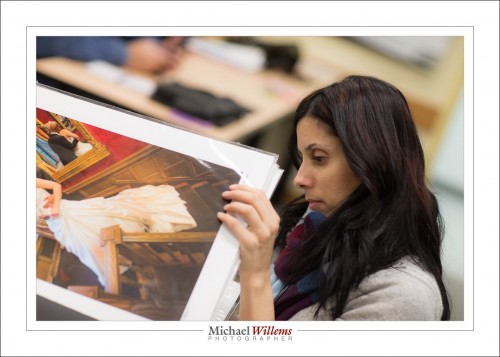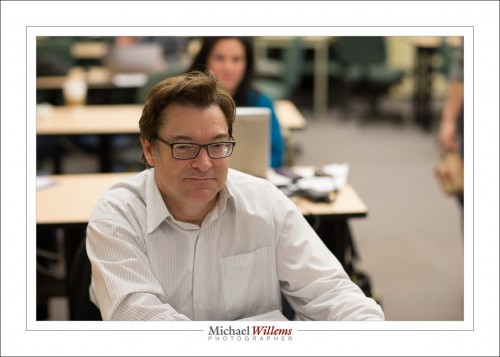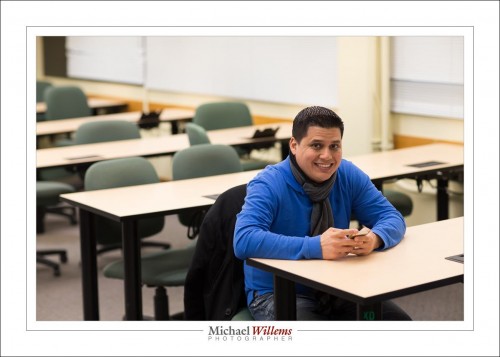I love my 85mm f/1.2 lens, as readers know. My students know it, too. Here’s one of them, from Wednesday’s “The Small Photography Business” class:
The 85mm is a prime (i.e. fixed, “non zoom”) lens. And 85mm is a great focal length for fashion pictures, portraits, and so on. And extremely fast: f/1.2 is a great wide open aperture value. Of course that does not mean I always have to use it at f/1.2. When you stop a lens down, it gets better, and when I stop this lens down, it is very good indeed.
The reason I like to use a prime is multi-faceted.
- I can shoot at faster shutter speeds or lower ISO values then with a cheaper lens. The pictures here were taken at 800 ISO, f/2.2, and 1/160th second in an evening classroom. Who needs a flash?
- I get wonderful blurry backgrounds, so I can live with less than ideal backgrounds, as in the photo above, I just blur them out.
- Primes are usually clearer and sharper than zooms, which are always to some extent a compromise.
But an oft-overlooked reason, and for me often the main reason, to use primes is that they give you a consistent shoot. You see, each time you zoom in or zoom out, a number of things change:
- Depth of field (how much is sharp in front of, and behind, where you focus).
- Minimum acceptable shutter speed if handholding the camera (think 1/f, where f is the focal length).
- Depth/perspective. Wide angle pictures look different from telephoto pictures. Long lenses compress perspective; wide lenses can exaggerate it.
- In a broader sense, the entire compositional look of your photos. A prime means you get to really understand the ins and outs of your shoot’s creative feel, rather than every picture being a new adventure. And it means that a shoot will have a certain feel, rather than being all over the place.
Here’s one last photo from last night, of another one of my talented students:
Your assignment, if you want one: do an entire shoot, or even shoot an entire week, with one prime lens. Be very careful with focus if you are shooting wide open: depth of field is extremely limited.
_________
- More hands-on courses in Oakville are imminent: http://cameratraining.ca(http://cameratraining.ca/Schedule.html




I always smile a little when someone says “Just try a mid-length prime for a while. Really.” My favourite photography teacher, way back when, wouldn’t let us use anything other than a fully manual 50mm f/2 for the better part of a year; fancy long zooms were something that came out on special occasions if you could make a case to justify your need for one. (If Cartier-Bresson could make history with one fixed optic, why would you think that you need much more stuff just to learn?) Even now, I usually just leave a 35/1.8 on the (Nikon DX) body more than half the time.